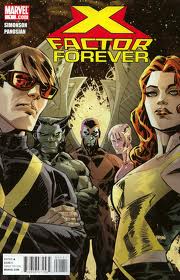X-Factor
http://en.wikipedia.org/wiki/X-Factor_(comics)
Comics Are Awesome – X-Factor
JD finally tackles one of the many sets of Marvel’s merry mutants with Peter David’s X-Factor. Cue the sleazy sax music!
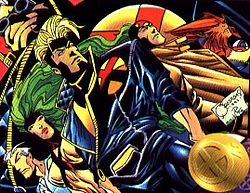 The 1990’s X-Factor team, Art by Joe Quesada.
The 1990’s X-Factor team, Art by Joe Quesada.
X-Factor is an American comic book series published by Marvel Comics. It is aspin-off from the popular X-Men franchise, featuring characters from X-Men stories. The series has been relaunched several times with different team rosters, most recently in X-Factor v. 3 as X-Factor Investigations.
X-Factor launched in 1986, featuring an eponymous team composed of the five original X-Men. In 1991, the founding members were incorporated back into the regular X-Men series, and X-Factor relaunched as a U.S. government-sponsored team incorporating many secondary characters from the X-Men mythos. The series was canceled in 1998.
In 2002, a four-part X-Factor mini-series detailed an investigation by the Mutant Civil Rights Task Force into an alleged conspiracy by hate-groups to commit murder against mutants. The series was written by Jeff Jensen with artwork byArthur Ranson.
In 2005, a new X-Factor series was launched, following the mutant detectiveagency X-Factor Investigations. Written by Peter David, the series drew acclaim from Ain’t It Cool News, as well as controversy for establishing a romantic relationship between Rictor and Shatterstar, a move criticized by Shatterstar’s co-creator, Rob Liefeld. The series also won a 2011 GLAAD Media Award for Outstanding Comic Book.
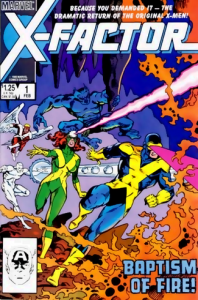 Volume 1 (1986–1998) Original team (1986-1991)
Volume 1 (1986–1998) Original team (1986-1991)
X-Factor launched in 1986 featuring an eponymous team composed of the five original X-Men that debuted in X-Men #1 (1963):
- Angel – A millionaire heir, capable of flight by means of two feathery wings extending from his back.
- Beast – A brilliant scientist possessing bestial strength and agility.
- Cyclops – Former X-Men team leader, with the ability to emit powerful “optic blasts” from his eyes.
- Jean Grey (Marvel Girl) – Cyclops’ long-time love, possessing telekinetic abilities.
- Iceman – A brash jokester, gifted with cryokinetic abilities.
The founding of X-Factor hinged upon the reunion of the original X-Men, an event complicated by the extensive histories of the characters following the initiation of a new team of X-Men in 1975.
In the 1970s and early 1980s, Angel, Beast, and Iceman wandered through various superhero teams. By 1985, all three were members of the Defenders, whose monthly series was shortly canceled, which freed the trio.
The returns of Cyclops and Jean Grey were more difficult. In the late 1970s, Jean Grey was killed during the seminal Dark Phoenix Saga, and was not originally conceived in the team’s female role, with fellow mutant Dazzler as the front-runner for that part. However, writer Kurt Busiek suggested a way to add Jean Grey to the roster that became one of the most significant cases of retconning in comic book history: Jean Grey had never actually been the Phoenix. Instead, the Phoenix entity copied Grey’s identity and form, keeping her safe in a cocoon-like structure beneath Jamaica Bay. Busiek related the idea to Roger Stern, who related it to John Byrne. Byrne wrote and illustrated Fantastic Four #286 (1985), incorporating Busiek’s idea.
In order to join the team, Cyclops walked out on his new wife Madelyne Pryor, anAlaskan pilot who bore a strange resemblance to Grey, and their infant son, Nathan Christopher. These events, along with the resurrection of Grey in general, were highly controversial with fans.
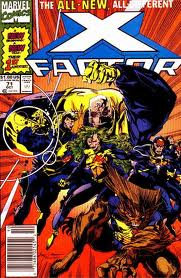 The original X-Men disassociated with the current team because Professor X had placed their old nemesis, Magneto, as its leader. The five set up a business advertised as mutant-hunters for hire, headquartered in the TriBeCa neighborhood of downtown New York City, posing as “normal” (non-superpowered) humans to their clients. The mutants X-Factor captured were secretly trained to control their powers and reintegrated into society. Through their “mutant hunting” they recruited a group of young wards:
The original X-Men disassociated with the current team because Professor X had placed their old nemesis, Magneto, as its leader. The five set up a business advertised as mutant-hunters for hire, headquartered in the TriBeCa neighborhood of downtown New York City, posing as “normal” (non-superpowered) humans to their clients. The mutants X-Factor captured were secretly trained to control their powers and reintegrated into society. Through their “mutant hunting” they recruited a group of young wards:
- Artie Maddicks – A pink-skinned, mute child who could project hologram-like images of his thoughts.
- Tabitha Smith – A young woman who ran away from her abusive father, who can create handheld energy spheres that she can explode at will, which she calls “time bombs”.
- Rusty Collins – A former member of the U.S. Navy whose pyrokinesis first manifested uncontrollably, severely injuring a woman.
- Leech – A green-skinned young boy, who can dampen the mutant powers of those around him.
- Rictor – A Mexican teenager who can produce powerful seismic waves.
- Skids – A runaway who could project a protective force field around her body.
The team would also go into action in costume, posing as mutant outlaws known as the “X-Terminators.” Eventually, the team decided that the “mutant hunter” ruse did more harm than good by inflaming hatred. Not only was the concept rejected, but it was blamed on X-Factor’s original business manager, Cameron Hodge, who was revealed as a mutant-hating mastermind.
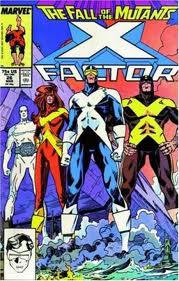 Bob Layton and Jackson Guice wrote and illustrated, respectively, the first few issues of X-Factor. They soon turned over creative duties to married collaborators Louise Simonson (writer) and Walt Simonson (artist). Louise introduced, in X-Factor #6 (1986), Apocalypse, who would appear in multiple issues and become X-Factor’s arch-nemesis. The Simonsons placed the series in line with the darker tone of most X-books. In X-Factor #10, the Marauders, a group of savage mutant mercenaries, severely injured Angel’s wings, which were later amputated. Despondent, Angel attempted suicide by detonating his airliner mid-flight, but Apocalypse rescued him from the wreckage and transformed him into Death, one of his Four Horsemen. Death was a fearsome creature that possessed metal wings and blue skin. Angel escaped Apocalypse’s control, but the physical changes to his body remained. He became known as Archangel and became a much darker character, eventually rejoining team in issue #36. Angel’s replacement on X-Factor, Caliban, turned to Apocalypse for more power in issue #24, with Apocalypse leaving X-Factor his ship in return.
Bob Layton and Jackson Guice wrote and illustrated, respectively, the first few issues of X-Factor. They soon turned over creative duties to married collaborators Louise Simonson (writer) and Walt Simonson (artist). Louise introduced, in X-Factor #6 (1986), Apocalypse, who would appear in multiple issues and become X-Factor’s arch-nemesis. The Simonsons placed the series in line with the darker tone of most X-books. In X-Factor #10, the Marauders, a group of savage mutant mercenaries, severely injured Angel’s wings, which were later amputated. Despondent, Angel attempted suicide by detonating his airliner mid-flight, but Apocalypse rescued him from the wreckage and transformed him into Death, one of his Four Horsemen. Death was a fearsome creature that possessed metal wings and blue skin. Angel escaped Apocalypse’s control, but the physical changes to his body remained. He became known as Archangel and became a much darker character, eventually rejoining team in issue #36. Angel’s replacement on X-Factor, Caliban, turned to Apocalypse for more power in issue #24, with Apocalypse leaving X-Factor his ship in return.
In the 1989 crossover Inferno, Madelyne Pryor was revealed to be a clone of Jean Grey created by the nefarious mutant geneticistMister Sinister. Demons had used Madelyne’s pain at Scott’s rejection of her to manipulate her into becoming the Goblyn Queen. Madelyne planned to sacrifice Nathan to open an interdimensional portal and to hurt Cyclops and Sinister as much as possible. X-Factor teamed up with the X-Men to rescue Nathan, bridging the gap between the two teams. Madelyne suffered a mental breakdown upon discovering she was a clone and killed herself.
During Inferno, X-Factor’s teenage wards, along with a young paraplegic mutant named Taki Matsuya, starred in the X-Terminatorsminiseries and shortly after folded into the X-Men’s junior team, the New Mutants.
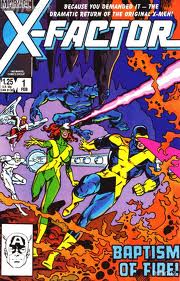 In the last major storyline of the first X-Factor series, published in early 1991, Apocalypse kidnapped Nathan Summers, sensing that he would grow up to be a powerful mutant and possible threat. X-Factor rescued Nathan from Apocalypse’s lunar base, but found him infected with a “techno-organic” virus that could not be treated in the present time. A clan of rebels from the future, known as the Askani, sent a representative to the present time to bring Nathan 2,000 years into the future to be treated. Fully grown, he would return to the 20th century as the antihero, Cable.
In the last major storyline of the first X-Factor series, published in early 1991, Apocalypse kidnapped Nathan Summers, sensing that he would grow up to be a powerful mutant and possible threat. X-Factor rescued Nathan from Apocalypse’s lunar base, but found him infected with a “techno-organic” virus that could not be treated in the present time. A clan of rebels from the future, known as the Askani, sent a representative to the present time to bring Nathan 2,000 years into the future to be treated. Fully grown, he would return to the 20th century as the antihero, Cable.
Shortly after this, the X-Factor, the X-Men, and several minor characters teamed up to fight the telepathic Shadow King in another crossover event, The Muir Island Saga. Afterward, the original members of X-Factor rejoined the X-Men and several minor characters from various X-Men-related series became founding members of the all-new X-Factor.
The era of the original X-Factor had lasting effects on the X-Men mythos. It introduced Apocalypse and the Archangel version of Angel and explained the connection between Apocalypse, Cable, Cyclops, Jean Grey, Pryor, and Sinister. All of these elements continued in future X-Men series.
Rather than end the series, Marvel hired writer Peter David and illustrator Larry Stroman to recreate X-Factor with new members, all of whom were already allies of the X-Men, and three of whom were involved in the Muir Island Saga. The new X-Factor worked for the Pentagon making them the only salaried mutant team. Their relationship with their benefactors was often strained and complicated. The new X-Factor, debuting in issue #71, included:
- Valerie Cooper – A U.S. government agent with history as both ally and adversary of the X-Men who became X-Factor’s government liaison, carrying over from her duties as liaison to a prior government-sponsored team of mutants, Freedom Force.
- Havok – A former X-Man and brother of Cyclops who could manipulate powerful, but hard to control, cosmic rays. Havok served as X-Factor’s leader.
- Multiple Man – He could create duplicates of himself on physical impact. He was previously offered X-Men membership, but he declined, opting instead to work at the Muir Island research centre.
- Polaris – Havok’s long-time lover and also a former X-Man who could control magnetism.
- Quicksilver – A long-running Avengers character and former foe of the X-Men, who possessed super speed and a difficult temperament. He was a late addition to the team roster.
- Strong Guy AKA Guido – A wise-cracking character who could rechannel kinetic energy aimed at him, transforming it into muscular mass and power. Lila Cheney‘s former bodyguard.
- Wolfsbane – A Scottish, former New Mutant who could transform into a wolf-like creature. Some artificial manipulation of her feelings caused her to love Havok, much against her will, and caused her much conflict and frustration because she knew he loved Polaris.
 Although X-Factor was not as flashy or wildly popular as other X-books, David was applauded for his use of humor and cultural references, and his ability to flesh out characters that had previously only been background characters.
Although X-Factor was not as flashy or wildly popular as other X-books, David was applauded for his use of humor and cultural references, and his ability to flesh out characters that had previously only been background characters.
David left in 1993. The series continued under writer J. M. DeMatteis and artist Jan Duursema, but struggled to distinguish itself among other X-books. Shortly after David’s tenure on the book ended, Forge, a former government weapons contractor whose mutant powers were his brilliant engineering skills, was added to the group; first replacing Cooper as their liaison after she had been compromised by one of Magneto’s Acolytes, and later as an active member. Cooper later became an active member as well, her marksmanship and athletic skills compensating for her lack of superhuman powers.
By 1995, Multiple Man had apparently died of the Legacy Virus, a deadly illness that attacked mutant genes, which was later revealed to have only killed one of his duplicates. Strong Guy was put into suspended animation after suffering a heart attack caused by the stress his extra mass put on his body. Wolfsbane, who had been cured of her artificial love for Alex, transferred to the European mutant team Excalibur. Havok left to infiltrate a mutant terrorist ring.
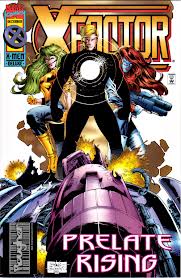 Writer John Francis Moore and illustrator Jeff Matsuda introduced a new X-Factor line-up, consisting of Forge as the team’s new leader, Polaris, Cooper, and several new recruits:
Writer John Francis Moore and illustrator Jeff Matsuda introduced a new X-Factor line-up, consisting of Forge as the team’s new leader, Polaris, Cooper, and several new recruits:
- Mystique – A shapeshifting mutant criminal and master of espionage. Mystique was forced to join X-Factor following her capture by federal agents.
- Sabretooth – A homicidal mutant criminal who possessed talons, heightened senses, and a healing factor. Like Mystique, Sabretooth was a captive member that Forge used special technology to control.
- Shard – A holographic computer program that took on the personality of the X-Man Bishop‘s deceased sister of the same name. Bishop was a time-traveler from a distant future, where he and Shard were members the X-Men descendants, Xavier’s Security Enforcers. The holographic Shard was brought to the 20th century with Bishop.
- Wild Child – Former member of Alpha Flight who possessed heightened senses, fangs, and claws.
Afterward, writer Howard Mackie injected more political and espionage elements into the series, a trend that culminated in the team’s secession from government sponsorship. Multiple Man and Strong Guy appeared again at the same time. Despite Forge managing to fix Strong Guy’s problems, he did not rejoin the team. The popularity of X-Factor continued to dwindle and Mystique and Sabretooth, two popular X-Men villains, failed to draw in more readers. Wild Child mutated out of control, Mystique hunted down Sabretooth (who had kidnapped young Tyler Trevor Chase), and Forge wanted nothing to do with X-Factor.
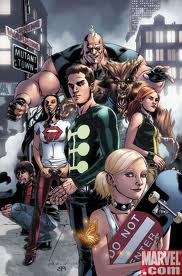 In 1997, Marvel attempted yet another revival. After various stories focusing on individual characters, a new team was gathered consisting of Havok, Multiple Man, Polaris, Shard, and other members of the X.S.E. (Fixx, and Greystone) that were brought to the 20th century (their teammate Archer, who also came back in time, turned down an offer to join)). However, this version of the team was disbanded in the same issue in which they debuted. In that issue, #149 (1998), Greystone built a time machine meant to take him and his compatriots back to the future. However, the device exploded, killing Greystone and, apparently, Havok. Afterward, X-Factor disbanded.
In 1997, Marvel attempted yet another revival. After various stories focusing on individual characters, a new team was gathered consisting of Havok, Multiple Man, Polaris, Shard, and other members of the X.S.E. (Fixx, and Greystone) that were brought to the 20th century (their teammate Archer, who also came back in time, turned down an offer to join)). However, this version of the team was disbanded in the same issue in which they debuted. In that issue, #149 (1998), Greystone built a time machine meant to take him and his compatriots back to the future. However, the device exploded, killing Greystone and, apparently, Havok. Afterward, X-Factor disbanded.
In fact, the time machine transported Havok to a parallel world, populated by twisted versions of Marvel characters. He explored this strange world in the series Mutant X, which lasted from 1998 until 2001. Although Marvel planned to revive X-Factor as an ongoing title after Mutant X ended, this did not happen for another 4 years.

